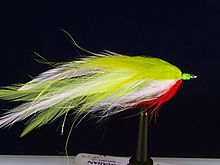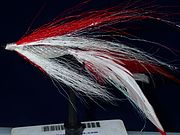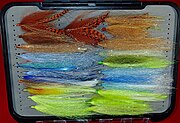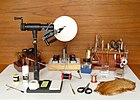|
Lefty's Deceiver
OriginIn the late 1950s, striped bass populations in the Chesapeake Bay were healthy and Lefty Kreh pursued them on a regular basis along the lower Eastern shore of the bay. He and his fishing partners faced a rather common issue with the big streamer flies of the time—feathers fouling around the hook. Saddle hackles secured near the eye of the hook, as was the common practice of the time, had a tendency to twist and foul around the hook bend during retrieves.[2] Fouled flies rarely deceived the wily striped bass. Lefty’s goal as he put it was: "I'm going to design a fly that won't foul on the cast! It will have a fish shape, but can be made in many lengths. You can vary the color combinations; it will also swim well but when lifted for the back cast it will be sleek and have little air-resistance."[3] The original Deceiver was all white and mimicked the prolific smelt that the Chesapeake Bay stripers foraged on. MaterialsThe original Lefty's Deceiver was tied with white saddle hackles tied in at the bend of a standard, short shank saltwater hook. Four to six hackles were used with tips curved to the outside. Flash was added on top of the hackles. The original body was silver tinsel. A collar of white buck tail was layered at the top, sides and bottom of the front of the hook. The buck tail extended just beyond the hook bend. Variations and sizesIn the 1960s when Lefty Kreh relocated to South Florida and began pushing the limits of saltwater fly fishing, the Deceiver grew in popularity and in variety. Today, the Deceiver is tied in an almost infinite number of color-material-size combinations. In 2012, Kreh published 101 Fish—A Fly Fisher’s Life List detailing many of his fly fishing exploits around the world. A great majority of those species were caught on variations of the Lefty’s Deceiver.[4] Fly tiers have recreated the pattern in a wide variety of colors and configurations to mimick the various fresh and saltwater forage fish that larger fish feed upon. GalleryLefty's Deceiver gallery References
|
||||||||||||||||||||||||||||||||||||||||








